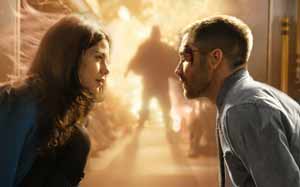 Michelle Monaghan and Jake Gyllenhaal star in a scene from the movie “Source Code.” The Catholic News Service classification is A-III – adults. The Motion Picture Association of America rating is PG-13 – parents strongly cautioned. Some material may be inappropriate for children under 13. (CNS photo/Summit)NEW YORK –– Taut direction by Duncan Jones and game performances all around help disguise the logical conundrums underlying the time travel-themed sci-fi thriller “Source Code” (Summit).
Michelle Monaghan and Jake Gyllenhaal star in a scene from the movie “Source Code.” The Catholic News Service classification is A-III – adults. The Motion Picture Association of America rating is PG-13 – parents strongly cautioned. Some material may be inappropriate for children under 13. (CNS photo/Summit)NEW YORK –– Taut direction by Duncan Jones and game performances all around help disguise the logical conundrums underlying the time travel-themed sci-fi thriller “Source Code” (Summit).
As for the musings on life, death and parallel existences that crop up in Ben Ripley’s screenplay, these are too confused either to challenge or reinforce beliefs of any stripe. Instead we’re left – as the closing credits roll – with a perfectly acceptable, though hardly original, message about seizing the day.
At the other end of the film’s sometimes grim and often claustrophobic proceedings, we’re as befuddled as he is when heroic Afghan War veteran Capt. Colter Stevens (Jake Gyllenhaal) awakens to find himself inhabiting the body of a stranger. Accompanied, apparently, by his girlfriend (Michelle Monaghan), said alter ego is a passenger on a Chicago-bound commuter train.
Long before Stevens can even begin to figure out what he’s doing there, however, the train is suddenly engulfed by a huge explosion, with obviously fatal consequences for everyone on board.
Jolted awake again – this time in an environment that resembles the helicopter he pilots in combat – Stevens gradually discovers that he’s part of a cutting-edge antiterrorism operation being run by Air Force Capt. Colleen Goodwin (Vera Farmiga).
As Goodwin explains via a video hookup, Stevens’ task is to keep reliving the last eight minutes of the other man’s life until he can identify the plotter who bombed the train, thereby forestalling a far worse follow-up attack.
The technology enabling Stevens to do so has been developed by Dr. Rutledge (Jeffrey Wright), an obviously over-intense, perhaps quasi-mad military scientist with an interest in harnessing the “afterglow” of dying people’s consciousness.
As “Groundhog Day” meets a Kafka novel, the downbeat atmosphere is offset by an emphasis on Stevens’ humanity. Thus we witness him falling for Monaghan’s character in one reality – their unique circumstances, needless to say, preclude any premarital shenanigans – and soliciting Goodwin’s help to reconnect with his estranged father in the other.
Both experiences eventually involve a blurring of chronology – not to mention the relation of cause and effect – that defies sober analysis. But most viewers will likely be happy enough with the surface entertainment on offer not to ask too many probing questions.
The film contains recurring action violence, some of it potentially disturbing, brief gory medical images, about a half-dozen uses of profanity, at least one instance of the F-word and some crude language. The Catholic News Service classification is A-III – adults. The Motion Picture Association of America rating is PG-13 – parents strongly cautioned. Some material may be inappropriate for children under 13.
Mulderig is on the staff of Catholic News Service. More reviews are available online at www.usccb.org/movies.
